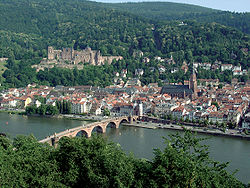Difference between revisions of "VIZBI2010"
| Line 40: | Line 40: | ||
'''Oliver Kohlbacher''' | '''Oliver Kohlbacher''' | ||
From Spectra to Networks - Visualizing Proteomics Data | From Spectra to Networks - Visualizing Proteomics Data | ||
| − | Shotgun proteomics means fragmenting proteins using enzymes (e.g., trypsin), then separate using mass spectrometry. Tandom-MS the first separation is via mass, then each peak is further broken down using direct collisions (collision-induced dissociation (CID). This enables determination of the sequence. | + | Again, very clear into to proteomics methodology. Shotgun proteomics means fragmenting proteins using enzymes (e.g., trypsin), then separate using mass spectrometry. Tandom-MS the first separation is via mass, then each peak is further broken down using direct collisions (collision-induced dissociation (CID). This enables determination of the sequence. |
| + | |||
| + | 2M maps are obtains: one dimension is charge/mass ratio, the other is retention time. | ||
| + | |||
| + | Role of visualization in proteomics: quality, manual/low-throughput analysis; validate automatic analyses (this is where the field is heading, more automation). | ||
| + | |||
| + | Primarily visualization is mass spectra themselves > signal process reduces them to 'stick' spectra (reduce data size by an order of magnitude). | ||
| + | |||
| + | 2D mass spectra - one of the problems is simply getting them into memory: they are up to 200GB. | ||
| + | |||
| + | Question: is that even with the 'stick' specrta? | ||
| + | |||
| + | A key problem is lack of data standards. | ||
| + | |||
| + | One dimension/data volume reduction is to fit the spectra to a mathematical model, then you can replace the data by the model. | ||
| + | |||
| + | Retention time and mass (the two primary dimensions) do not have a 'biological' meaning. | ||
| + | |||
| + | Can compare two samples (e.g., disease vs healthy tissue), can create expression profiles that are similar to gene expression profiles. | ||
| + | |||
| + | Key challenges: data volume (hence need data reduction); however, experimentalists always need to go back to the raw data/spectra; integration with other omics data and networks; rapidly changing experimental techniques (difficult to keep up). | ||
=== Posters 'T' === | === Posters 'T' === | ||
Revision as of 08:58, 4 March 2010
Home < VIZBI2010| This wiki page can be used to provide supplemental information, links, and discussion for topics covered in the VIZBI 2010 conference in Heidelberg March 3-5, 2010 at the EMBL. |
Contents
VIZBI Links
Special Issue of Nature Methods
The speakers collaborated on a set of papers summarizing the current state of bioimaging visualization that were published as a special issue of Nature Methods.
Comments on friendfeed
Community notes are available on friendfeed: http://friendfeed.com/vizbi2010
Wednesday
MRI
- Pieper:
- Slides.
- Movies, slide shows, and documentation for the Query Atlas project mentioned during the talk can be found on this page.
- Open source software for MRI processing can be found at the 3D Slicer web site.
- The National Alliance for Medical Image Processing provides resources and opportunities for collaboration on image analysis topics.
Posters 'W'
Optical Microscopy
Keynote
Thursday
Systems Biology
Matt Hibbs Matt gave a beautifully clear into to expression array analysis. He also discussed his own tool HIDRA enables comparison of several heat maps, each from different experiments.
Oliver Kohlbacher From Spectra to Networks - Visualizing Proteomics Data Again, very clear into to proteomics methodology. Shotgun proteomics means fragmenting proteins using enzymes (e.g., trypsin), then separate using mass spectrometry. Tandom-MS the first separation is via mass, then each peak is further broken down using direct collisions (collision-induced dissociation (CID). This enables determination of the sequence.
2M maps are obtains: one dimension is charge/mass ratio, the other is retention time.
Role of visualization in proteomics: quality, manual/low-throughput analysis; validate automatic analyses (this is where the field is heading, more automation).
Primarily visualization is mass spectra themselves > signal process reduces them to 'stick' spectra (reduce data size by an order of magnitude).
2D mass spectra - one of the problems is simply getting them into memory: they are up to 200GB.
Question: is that even with the 'stick' specrta?
A key problem is lack of data standards.
One dimension/data volume reduction is to fit the spectra to a mathematical model, then you can replace the data by the model.
Retention time and mass (the two primary dimensions) do not have a 'biological' meaning.
Can compare two samples (e.g., disease vs healthy tissue), can create expression profiles that are similar to gene expression profiles.
Key challenges: data volume (hence need data reduction); however, experimentalists always need to go back to the raw data/spectra; integration with other omics data and networks; rapidly changing experimental techniques (difficult to keep up).

